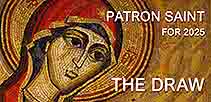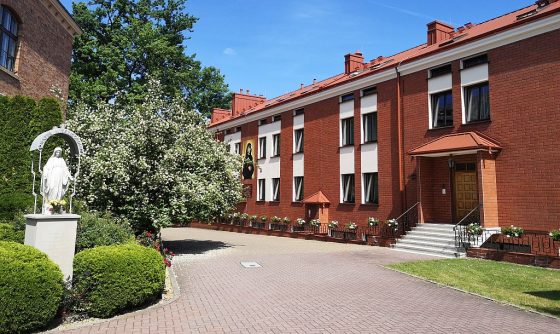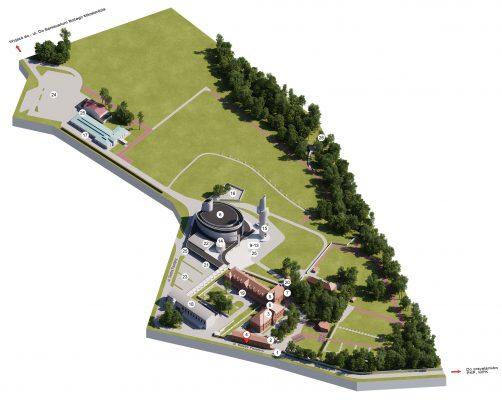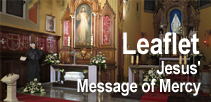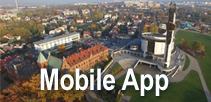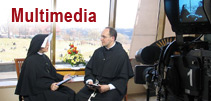We have put a map of the Shrine after the text.
The building adjoining the street (ulica Siostry Faustyny) is called Antoninek House and was put up on the site of the old entrance gate and the single-storey building which used to accommodate guest rooms for visiting Sisters and a quarantine area for those who were suffering from an infectious disease. Sister Faustina lived for several months, most probably from September 1937, in one of the rooms on the first floor, when she was very ill with tuberculosis and the doctor recommended isolation. She continued with her job in the porter’s lodge at the entrance gate until the end of December 1937, and later when she was fit enough in the porter’s lodge next to enclosure, and continued to work in her cell with her tatting shuttle, making frivolité lace borders for the convent’s altar-cloths. Lots of things happened during the few months she spent in her cell at Antoninek House. She made records of a variety of over fifty apparitions of Jesus and Our Lady and revelations, as well as of encounters with the Devil whom she had to fight off. Jesus visited her 41 times and spoke to her about the mission of preaching Mercy.
Somewhere in the Łagiewniki convent in October 1937 Jesus told Sister Faustina about the devotion to the Divine Mercy at the Hour of Mercy, that is a prayer said at the time when he died on the Cross. “At three o’clock,” He said, “beg for My mercy, especially for sinners, and immerse yourself, even for a short moment, in [contemplation on] My Passion. . . . That is the hour of great mercy for the whole world” (Diary 1320). An event which definitely took place in Antoninek House was the next revelation concerning the Hour of Mercy, in which Jesus not only recalled this devotion but also said how it could be practised: by doing the Stations of the Cross, by visiting Him in the Blessed Sacrament, and by uniting with Him dying on the cross wherever we happen to be at three o’clock in the afternoon. The prayer, even the shortest prayer, we offer up for this devotion, may, for instance, be a moment of contemplation on God’s merciful love revealed in the Passion and Death of the Son of God. The prayer should be addressed directly to Jesus, and invoke the merit of His sorrowful Passion. “At this hour,” He promised, “I shall not refuse anything that a soul may ask of Me, for the sake of My Passion…” (Diary 1320). Every day, not just on Good Friday or on a Friday, three o’clock in the afternoon is a specially blessed time anywhere you happen to be in the world, a time when you can transport yourself in spirit to Calvary, stand next to the Cross with Our Lady and for a brief moment unite with Jesus as He dies, unite your life with His suffering on the Cross, and through the merit of His Passion beg for graces and mercy for yourself and for the whole world.
At Antoninek House Jesus also made the following promise to priests and all who worship the Divine Mercy, “All the souls that worship My mercy and spread its praise, encouraging other souls to trust in My mercy, shall be spared the experience of dread at the hour of death” (Diary 1540), thereby making the spreading of the message of Mercy one of the devotions, alongside the Holy Picture, the Feast, the Chaplet, and the Hour of Mercy, and promising His loving care in life and at the hour of death to those who worship in this way.
To accomplish the mission of spreading His message of Mercy throughout the world, Jesus instituted “a new congregation,” the Apostolic Movement of the Divine Mercy, whose origins go back to Sister Faustina’s charism and mystical experiences. It is made up of a variety of active and contemplative, male and female religious congregations, hermits, a diversity of communities, confraternities, and laypeople who are bringing God’s merciful love into the world by witnessing to it with their lives, words and deeds, and prayers.
One of these communities is the Faustinum International Association of Apostles of Divine Mercy, which has its headquarters in Antoninek House. Faustinum has a membership of priests, religious, and laypeople from 90 countries all over the world who want to join in St. Faustina’s prophetic mission. The Association was erected by Cardinal Franciszek Macharski in 1996 and conducts a formation programme in several languages for Apostles of Divine Mercy, on the basis of the Word of God, the Church’s teaching, and St. Faustina’s school of spirituality. It organises meetings, days of recollection, retreats, conferences and congresses, and preaches the message of Mercy in Poland and other countries.
Other institutions operating in the Shrine of Łagiewniki which help to spread the message of Mercy in many languages include the Misericordia Publishing House, the daily pastoral services we provide for pilgrims, our quarterly magazine Orędzie Miłosierdzia, the Chaplet for the Dying, the Perpetual Chaplet, our website, internet and media services, as well as our activities in scholarship, the arts, and culture.
- Main entrance to the Shrine
- Sister Faustina’s House: hotel & museum
- Convent
- Antoninek House: Faustinum Association
-
Merciful Jesus Chapel & Saint Faustina’s Tomb: Heart of the Shrine
- Oratory: room where Saint Faustina died
- Chapel of the Lord’s Passion
- Divine Mercy Basilica
- Saint Faustina’s Chapel
- The Communio Sanctorum Chapel
- Saint Andrew’s Chapel
- The Holy Cross Chapel
- The Chapel of Our Lady of the Seven Sorrows
- Perpetual Adoration Chapel
- Viewing Tower
- Convent Graveyard
- Sister Faustina’s House: restaurant, souvenirs & meeting hall
- Pastoral Lodge: hotel & restaurant
- Mercy House
- Information Booth
- Souvenirs & Misericordia Bookshop
- Saint John Paul II Hall
- Car park
- Car and coach park
- Toilets
- Bridge of Mercy, for the Saint John Paul II Shrine & tram stop










